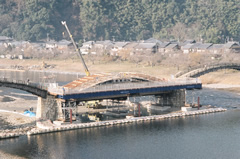History
History of the Kintaikyo Bridge
The Edo Period (1603 - 1868)
On June 28, 1673 by the lunar calendar (August 10, 1673, by the present solar calendar), a groundbreaking ceremony took place to initiate construction of the first Kintaikyo Bridge (arch bridge), which was completed on September 30 (November 8 by the present calendar), and officially opened on October 3 (November 11 by the present calendar). Surprisingly, the work was completed only in three months. This first bridge, however, was carried away by a storm on May 28, 1674 (July 1 by the present calendar). The arch bridge collapsed following the loss of its three piers due to erosion of the surrounding riverbed. Bridge rebuilding commenced on June 1 in the same year (July 4 by the present calendar). The rebuilding project, in which the footing of the piers was made particularly strong, was completed on October 25 (November 22 by the present calendar); the new bridge was officially opened on November 3, 1674 (November 30 by the present calendar).
The Showa Period (1926 - 1989)
 |
| Photo 23: Rebuilding the Bridge during the Showa Period (1926 - 1989) (for reference) |
The second bridge remained intact for 276 years. Because of insufficient maintenance during the post-World-War-II period, however, the Bridge was carried away by the typhoon that struck Iwakuni on September 14, 1950. At the meeting held in Tokyo to discuss reconstruction plans, some suggested that the new bridge be constructed using concrete. Representatives of Iwakuni, however, strongly insisted that a bridge of the original design be rebuilt.
The Heisei Period (1989 - today)
 |
| Photo 24: Alternative bridge installed during the first phase of the project |
During the Heisei Period, rebuilding was carried out to construct the fourth Kintaikyo (present bridge). Because of restrictions on the project period, which is limited to the dry season, as well as other restrictions relating to procedures for gaining governmental permission, the project was implemented in three phases, which spanned three years. Since the Kintaikyo Bridge is an essential tourist resource for Iwakuni, the long duration of the project period had serious negative impact on the tourist industry. To mitigate the anticipated loss, it was decided that an alternative bridge would be built, from which tourists and local people would be able to view the rebuilding process (Photo 24).
While the alternative bridge enabled people to cross the river, increasing numbers of tourists began visiting Iwakuni to view the project site. Their number, which was below 700,000/year immediately before initiation of the project, gradually increased, reaching over 1 million/year by the end.
